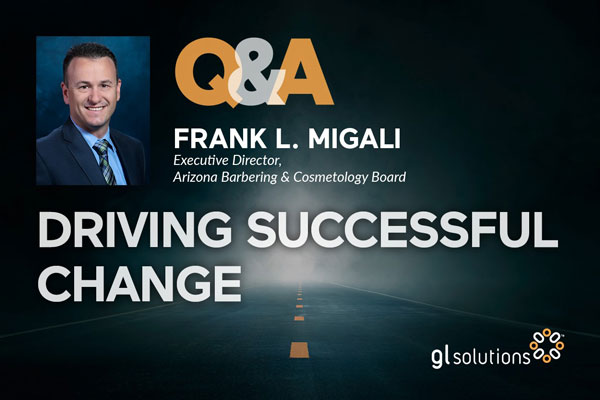Arizona Barbering and Cosmetology Board’s Executive Director Frank Migali shares the return on investment of positive customer experiences and how he validates the success of changes at his agency in an interview with GL Solutions.
GL: Can you share a change or changes that you made recently that you’re excited about?
Frank Migali: So I think one specific thing that I’m going to point to is, I joined this agency and I was really kind of shocked and surprised that when we issued licenses, we were physically printing and stuffing the license in an envelope and paying 55 or 60 cents apiece to mail those. And about the same time I had to renew my hunting and fishing license with one of my other peer state agencies. And I had to print my own license. And I thought, wait a minute. So I start running numbers. And I’m very data driven. And so I talked with my team. I asked them how much money are we spending on postage annually? And we found the number; it was $60,000 that my $2.5 million agency was spending on postage. I’m like, okay, how can we change that?
My idea was that we email the individuals that are licensed, and they print it. Because we do have a regulatory requirement that those licenses be posted in the place of work. I thought, how can we transition to that? My team at the time said, we explored that a couple years ago, and we were told it was going to cost $10,000 to make the IT system change to implement that. And I said, I will always invest $10,000 to save $60,000. And so we definitely partnered and we accomplished that. And we fully realized that cost savings. Our April postage bill was $42.
When we talk about change management return on investment, that’s really what I’ve been talking about.
I have a vision of world class customer care in this organization. And so I was in a meeting with my team yesterday and asked the question, what return on investment do we get for a positive customer experience? And my team was just silent. And they said, well, there’s not a financial return on investment. I said, what about that customer experience? There is a return on investment there. If we have happy customers, they’re going to come back. And they’re going to tell people about the great work that we’re doing and how quickly we process licenses and how easy that process is.
GL: Can you talk about some of the challenges that you faced with implementing some of this change?
Frank Migali: So I spent a year really focusing on developing a mission and vision for the organization and most importantly our vision—and getting the buy in. So first and foremost, it’s super important for me to have the buy in from my team or teams to that vision. Because that’s what really gets people to come alongside; and when people come alongside, they’re willing to identify problems. They’re willing to help solve those problems. I would be lying if I said in my leadership journey, that that is easy. It is not easy. Leadership is not easy.
My desire is always being open and honest with the team and being transparent about the direction that we’re going or where our pitfalls are. So I do think I have had a number of challenges in this and that’s everything from making IT system changes and them taking longer than I want them to. So even from that perspective of development, there’s issues and then there’s even staffing issues. Let’s go back to that IT system change example where we don’t get our part of the work done within the timeline, so it delays things overall. That’s been a challenge for me to get the team to understand that these things are a priority, and that my strategic direction and strategic vision are my number one priority.
And the other challenge is I have not been able to clearly articulate that when we make process change, it’s twofold. The process change isn’t just about the customer. And it isn’t just about our internal process. It’s got to be a combination of improving the process for both the customer and us internally. And how do we find that middle ground to change the process for our customers and us internally?
Change is difficult. I tell my staff I understand change is difficult. But we all need to get comfortable with it. Because change is the only constant in life. Everything changes.
GL: What are some of the ways that you validate that change was successful?
Frank Migali: Data, data data. I cannot reiterate that enough. Data is the sole item for me that validates that our change is successful. Going back to my original example of our mail, our print license change that we made within our IT system. It actually didn’t even end up costing $10,000. I think it was less than $7,000 to make that investment. So, I told the board we are making this investment of $7,000 to change the IT system. But our year one savings on postage alone is going to be $60,000. I think for them, it was a no brainer. We’re saving on paper. We’re saving on envelope cost. We’re saving on the actual staff time to do those things so we can improve our license processing time, because we’ve gained an additional three hours a week of work time, not stuffing licenses.
GL: Where did your energy come from to make changes at your agency?
Frank Migali: It’s probably twofold. Number one, I am naturally geared to process improvement and improving things where I see there are problems. I don’t use the word problem as a negative because I think in government, we have failed for so long to identify problems and truly solve and fix those. And I was very fortunate in my last role in state government to receive a significant amount of training in two different areas. Number one was advanced leadership training; and that was really about leadership styles and how to approach things with individuals. And very fortunate that my state agency chose to invest in me in that skill set. And the second piece was what we call the Arizona Management System, which is really based on Lean Management principles.
Editor’s note: Answers edited for clarity and brevity. To hear the entire interview, listen to our interview with Frank Migali on our Talkin’ SaaS podcast.
Run, Grow and Adapt
Subscribe to our newsletter to receive the latest regulatory news delivered to your inbox each week.
GL Solutions helps governments run, grow and adapt. To learn more, explore our website, call us at 800.930.1193 or email us at hello@glsolutions.com.


